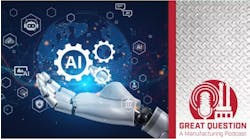Manufacturing, however, holds some of the most exciting opportunities and offers the most economic benefit in terms of cost savings, new revenue streams and efficiencies. Our near-term focus should be broader visibility of critical machine health through connectivity and reporting.
Bruce Sinclair's “The Internet of Things Show” podcast recently featured a great interview with SAP’s Tanja Rueckert, who detailed how IoT-enabled solutions in connected manufacturing include connectivity, intelligence, pattern analysis and, ultimately, predictability. She noted how predictive maintenance should be used as predictive algorithms to extend the life of machines, akin to a doctor-patient relationship in which the caregiver maintains a holistic view of health.
As OT connects with IT, Rueckert notes, production and core business processes increasingly have end-to-end connectivity (what is known as visibility from the shop floor to the top floor). Machine-learning algorithms and mapping back to core ERP systems are fully integrated into the value chain.
Mass customization is another attractive element of the IIoT. It pops up in many of the business conversations I have. The focus has primarily been on connectivity, OT/IT convergence and analyzing the business processes in between. But I see increasing interest in disseminating to a wider audience the information that comes from these developments.
Shop floor to top floor connectivity, as Rueckert calls it, is critical—sharing the operator's visibility with maintenance professionals who analyze usage patterns and trends in order to address issues before they become costly problems. This, of course, extends the lives of machines.
For example, pump-vibration analysis (reading massive amounts of data each second) can now be easily exported and shared with the right people. Incidents of the “operator just shuts off the machine,” which entails costly machine downtime, is no longer the right protocol, as the operator is not a maintenance technician. In fact, the operator—oftentimes a contractor—is not even at the facility, which makes this IIoT enablement even more valuable.
Dan Yarmoluk is an IoT business-development executive with AssetScan. Reach him at [email protected]


